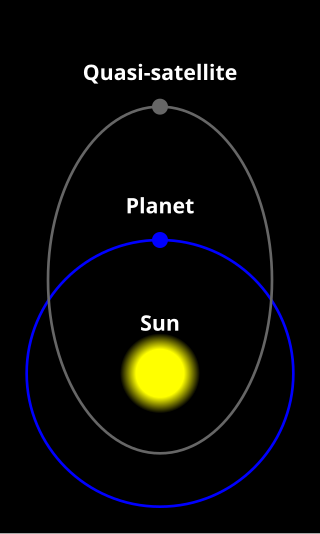2003 YN107 is a tiny asteroid, classified as a near-Earth object of the Aten group moving in a 1:1 mean-motion resonance with Earth. Because of that, it is in a co-orbital configuration relative to Earth.

A quasi-satellite is an object in a specific type of co-orbital configuration with a planet where the object stays close to that planet over many orbital periods.

54509 YORP (provisional designation 2000 PH5) is an Earth co-orbital asteroid discovered on 3 August 2000 by the Lincoln Laboratory Near-Earth Asteroid Research (LINEAR) Team at Lincoln Laboratory Experimental Test Site in Socorro, New Mexico. Measurements of the rotation rate of this object provided the first observational evidence of the YORP effect, hence the name of the asteroid. The asteroid's rate of rotation is increasing at the rate of (2.0 ± 0.2) × 10−4 deg/day2 which between 2001 and 2005 caused the asteroid to rotate about 250° further than its spin rate in 2001 would have predicted. Simulations of the asteroid suggest that it may reach a rotation period of ~20 seconds near the end of its expected lifetime, which has a 75% probability of happening within the next 35 million years. The simulations also ruled out the possibility that close encounters with the Earth have been the cause of the increased spin rate.
Seppo Mikkola is a Finnish astronomer. He is a senior lecturer at the University of Turku and staff member at Tuorla Observatory.
Paul Arnold Wiegert is a Canadian astronomer, discoverer of minor planets and professor at the University of Western Ontario.
(322756) 2001 CK32 is a sub-kilometer asteroid and near-Earth object of the Aten group. It is also a transient Venus co-orbital, and a Mercury grazer as well as an Earth crosser. It was once designated as a potentially hazardous asteroid.
(164207) 2004 GU9 is a sub-kilometer asteroid, classified as near-Earth object and potentially hazardous asteroid of the Apollo group. It will be a quasi-satellite of Earth until around 2600.
2012 XE133 is an asteroid, classified as near-Earth object of the Aten group that is a temporary co-orbital of Venus.
2013 ND15 (also written 2013 ND15) is an asteroid that is a temporary trojan of Venus, the first known Venus trojan.
2014 OL339 (also written 2014 OL339) is an Aten asteroid that is a temporary quasi-satellite of Earth, the fourth known Earth quasi-satellite.
2013 LX28, is an asteroid, classified as near-Earth object of the Apollo group that is a temporary quasi-satellite of the Earth, the third known Earth quasi-satellite.
2015 SO2 (also written 2015 SO2) is an Aten asteroid that is a temporary horseshoe companion to the Earth, the ninth known Earth horseshoe librator. Prior to its most recent close encounter with our planet (2015 September 30) it was an Apollo asteroid.
2015 XX169 (also written 2015 XX169) is an Apollo asteroid that is a temporary horseshoe companion to the Earth, the tenth known Earth horseshoe librator. A close encounter with the Earth on 14 December 2015 caused the value of the semi-major axis of 2015 XX169 to drift slowly upwards, and the object evolved from an Aten asteroid to an Apollo asteroid about a year after this close approach.
2015 YQ1 (also written 2015 YQ1) is an Apollo asteroid that is a temporary horseshoe companion to the Earth, the twelfth known Earth horseshoe librator. It experienced a close encounter with the Earth on 2015 December 22 at 0.0037 AU.
2015 YA is a sub-kilometer asteroid, classified as near-Earth object of the Aten group, that is a temporary horseshoe companion to the Earth. It is the 11th known Earth horseshoe librator. Prior to a close encounter with the Earth on 15 December 2015, 2015 YA was an Apollo asteroid.

594913 ꞌAylóꞌchaxnim (provisional designation 2020 AV2) is a large near-Earth asteroid discovered by the Zwicky Transient Facility on 4 January 2020. It is the first asteroid discovered to have an orbit completely within Venus's orbit, and is thus the first and only known member of the eponymous ꞌAylóꞌchaxnim (informally named Vatira before its discovery) population of Atira-class asteroids. ꞌAylóꞌchaxnim has the smallest known aphelion and third-smallest known semi-major axis among all asteroids. With an absolute magnitude approximately 16.2, the asteroid is expected to be larger than 1 km in diameter.
2020 VT1 is a small asteroid, classified as a near-Earth object of the Amor group, that is a temporary horseshoe companion to Mars.
2020 PN1 is a sub-kilometer asteroid, classified as a near-Earth object of the Aten group, that is a temporary horseshoe companion to the Earth. There are dozens of known Earth horseshoe librators, some of which switch periodically between the quasi-satellite and the horseshoe co-orbital states.
2020 PP1 is a sub-kilometer asteroid, classified as a near-Earth object of the Apollo group, that is a temporary quasi-satellite of the Earth. There are over a dozen known Earth quasi-satellites, some of which switch periodically between the quasi-satellite and horseshoe co-orbital states.




